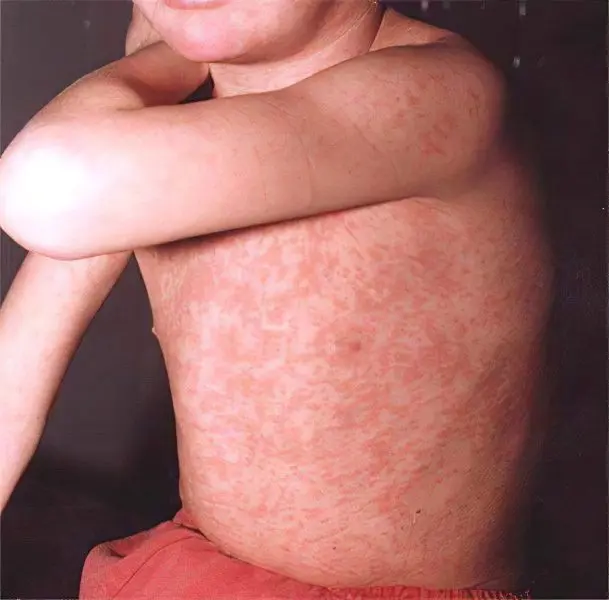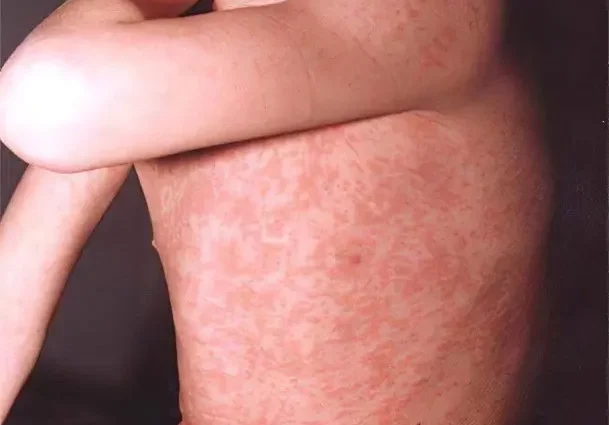
The causative agent of rubella measles belongs to the family Togaviridae and is considered the only one of the genus Rubivirus. Until 1834, rubella was considered a type of measles.
Rubella measles was recognized as a nosological unit in 1881 within the framework of the International Congress held in England. However, until about the middle of the XX century. due to the mild course of the pathology and the small number of recorded complications of the disease, which proceeds according to the classical scenario, the disease practically did not attract the attention of specialists.
In 1942, the Austrian ophthalmologist N. M. Greg noted an increase in the frequency of congenital malformations and cases of cataracts in babies born after an epidemic of measles rubella. Over time, this fact was confirmed by numerous studies that revealed the teratogenic effect of the pathogen on the fetus, causing damage to many of its organs and systems.
Symptoms of measles rubella
Rubella can be of two types: congenital and acquired. In the first case, the pathogen enters the fetus with the mother’s blood, and the frequency of infection during pregnancy depends on the immunity of the future mother to this infectious disease.
Acquired measles rubella occurs through the airborne route of infection. The causative agent begins to be released from the nasopharynx of an infected person at least a week before the appearance of characteristic clinical symptoms – a rash, in addition, this process can continue for several more days after the disappearance of the rash. The maximum risk of infection occurs on the first day of the rash.
Subclinical forms of pathology are considered the most dangerous for the environment of a sick person, it is important to note that this particular form of the disease is the most common. Infection occurs only through direct contact with the patient, most often with close and prolonged communication. The disease is characterized by high contagiousness (70–90%).
Maternal immunity to the rubella pathogen ensures that the child is immune to the disease in the first year of life. The most common pathology occurs between the ages of two and nine years.
The incubation period for rubella lasts 11-21 days. If the course of the disease is accompanied by severe clinical manifestations, which is typical for 70–80% of cases, then after the end of the incubation period, a prodromal period begins, lasting up to two days.
A constant symptom of measles rubella is polyadenitis, which occurs with a moderate increase in the posterior cervical and occipital lymph nodes. In such patients, they become dense and painful on palpation. The enlargement of the lymph nodes can be so pronounced that such a manifestation of the disease becomes noticeable.
In addition, during this period of the disease, the body temperature rises to 37,5-38 ° C, there is an unexpressed catarrhal inflammation on the mucous membrane of the respiratory tract, on the conjunctiva, a roseolous enanthema is noticeable on the surface of the hard palate.
Rashes with measles rubella cover the entire body, and the nature of the rash is roseolous and maculopapular. Individual elements do not merge with each other. The maximum concentration of the rash is noted on the limbs, back, buttocks and on the outer surface of the thighs.
On the second day, and sometimes at the end of the first day of illness, the number of rashes decreases, and the formations themselves become small, resembling the manifestation of scarlet fever. Completely the rash disappears after three days, leaving no traces and peeling.
In adolescence, acquired rubella is more severe than in children. Patients have symptoms of intoxication, the temperature rises to febrile values, chills, muscle pain, catarrhal phenomena in the form of dry cough, itching in the throat, conjunctivitis, runny nose are observed. The rash in this case is more pronounced, spotted, and individual spots can merge with each other.
Girls with measles rubella may have arthritis and arthralgia. The clinical symptoms of rubella in this case are expressed in the form of pain, redness, swelling of the joints. The joints of the upper extremities (fingers, elbow joints) and knee joints are most often affected. These symptoms appear a week after the rash and disappear within the next week.
In rare cases, thrombocytopenia is noted, in about half of the cases it acquires a chronic course.
Autoimmune encephalitis is considered the most serious consequence of the pathology, it occurs in one case out of 5 or out of 000 cases of measles rubella, and this complication is most common among schoolchildren and in adult patients. When the meninges are involved in the process, meningoencephalitis occurs.
Central disorders of the cardiovascular and respiratory systems pose the maximum threat to patients. The number of deaths in this case is 20-35%. In 30% of patients, after the passage of clinical symptoms of measles rubella, residual effects are noted.
In 1975, cases of progressive rubella panencephalitis were first reported in patients aged 10 to 20 years. The complication is accompanied by a decrease in coordination of movements and intelligence. The disease takes a chronic course and ends with the death of patients after 1–10 years.
Rubella panencephalitis of the brain is accompanied by a change in the white matter, while it becomes gray and soft due to demyelination and loss of glia by cells, as well as due to damage to the cerebral vessels. The nature of the process is immunopathological.
Rubella treatment
To date, there are no specific treatments for measles rubella, both congenital and acquired. At the same time, pathogenetic therapy helps prevent the development of serious complications (encephalitis, cerebral edema, fever, seizures).
Patients in whom the disease proceeds without complications are treated at home. They need bed rest during the acute manifestation of symptoms of the disease and symptomatic therapy.
Congenital measles rubella is treated in a specialized hospital, and therapy depends on clinical manifestations.










